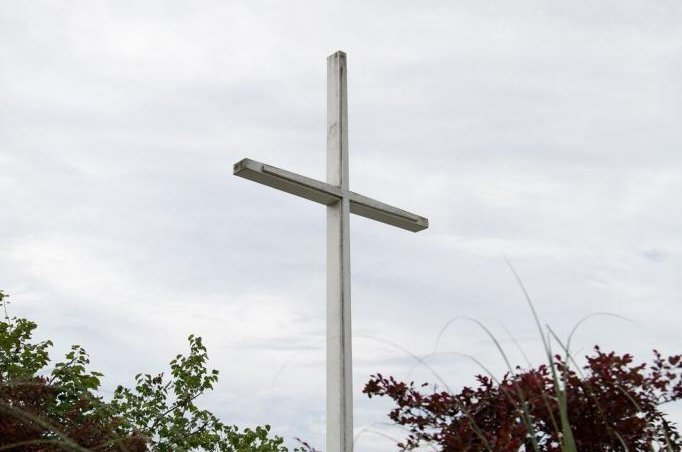US & SCOTUS Court rulings on crosses favor history over religion
CHRISTIANS CLAIM THEIR RELIGIOUS SYMBOL THE CROSS
IS SECULAR FOR VETERANS PUBLIC MEMORIALS

An appeals court said the message conveyed by this cross
in Bayview Park in Pensacola, Fla., has evolved into a neutral
one since its erection in 1941.
Photo courtesy of Becket Fund for Religious Liberty
March 6 (UPI) -- Recent court rulings favoring historic preservation over religious implications may turn the tide in legal battles across the United States over crosses depicted on public property.
In Pensacola, Fla., an appeals court ruled that a 34-foot-tall cross can remain in a park, rejecting an argument that the display should be removed because its maintenance by the city violates the U.S. Constitution's Establishment Clause, which prohibits the government from favoring one religion over others.
In a 3-0 opinion, the 11th U.S. Circuit Court of Appeals said the message conveyed by the cross has evolved into a neutral one since its erection in 1941 in Bayview Park. Furthermore, the passage of time has imbued the cross with historical significance. Removing it might appear to be hostile, rather than neutral, toward religion, according to the Feb. 19 ruling.
In finding the cross constitutional, the 11th Circuit was guided by a 2019 U.S. Supreme Court opinion that allowed a 40-foot-tall cross that commemorates area residents who died in World War I to remain on public land in Bladensburg, Md. That ruling -- in American Legion vs. American Humanist Association, which said the Bladensburg cross has taken on a secular purpose and acquired historical importance -- also was the basis of a decision permitting Lehigh County, Pa., to keep a Latin cross on its seal.
RELATED Supreme Court: WWI memorial cross doesn't violate church-state clause
Sam Gerard, a communications associate for the AHA, said the crosses are "explicitly religious" and violate the separation of church and state. The association, which, along with the Freedom From Religion Foundation, filed a lawsuit on behalf of four plaintiffs seeking removal of the Pensacola cross, is weighing whether to appeal.
The impact of the Supreme Court opinion will be felt in other cases, said Luke Goodrich, vice president and senior counsel for the Becket Fund for Religious Liberty, which represented Pensacola and Lehigh County in their battles over the crosses.
Courts will increasingly rely on the history of religious symbols in deciding challenges to their constitutionality, "which will produce more objective and religion-friendly results," Goodrich told UPI in an email.
RELATED Supreme Court to hear Philadelphia case on same-sex foster parents
"Bladensburg will lead to more rulings allowing religious displays (especially longstanding ones) in public places," Goodrich said.
Rebecca Markert, the foundation's legal director, said Bladensburg has opened the door to symbols that would have been considered religious a few years ago. She said the Bayview Park cross was built to serve as the centerpiece of annual Easter sunrise services.
"It's a blow to religious liberty," Markert said.
The ruling is a double blow, she added, because it will not lead to a lot of minority religious symbols on public property. Instead, the government, which decides what to display, will likely maintain traditional Christian symbols, Markert said.
'Presumption of constitutionality'
Construction of the Bladensburg cross -- called the Peace Cross -- began in 1918. The Maryland-National Capital Park and Planning Commission acquired the cross and the land in 1961 and uses public funds for maintenance.
In 2012, the AHA and three residents of Washington, D. C., and Maryland, sued the commission in federal court. The plaintiffs alleged the cross's presence on public land and the commission's maintenance of it violate the Establishment Clause.
A district court judge ruled in favor of the commission and the American Legion, which had intervened in the suit to defend the cross. The 4th U.S. Circuit Court of Appeals reversed, and the case was appealed to the Supreme Court, which issued its 7-2 opinion June 20, giving a "presumption of constitutionality for longstanding monuments, symbols and practices."
"Even if the original purpose of a monument was infused with religion, the passage of time may obscure that sentiment," Justice Samuel Alito wrote in the majority opinion. "As our society becomes more and more religiously diverse, a community may preserve such monuments, symbols and practices for the sake of their historical significance or their place in a common cultural heritage."
Lehigh County's seal was adopted in 1944 and depicts images reflecting its history, including a cross that honors the Christians who settled the area. Other images that reflect the county's history and culture are cement silos, textiles, a farm, the Liberty Bell and a lamp with books that represents schools.
The Wisconsin-based foundation and four of its members sued in 2016 to get the cross removed, and a federal judge ruled in their favor, saying the cross lacked a secular purpose and was unconstitutional.
The case went to the 3rd U.S. Circuit Court of Appeals, which put it on hold until the decision in the Bladensburg case was issued. On Aug. 8, the 3rd Circuit ruled 3-0 that the seal does not violate the Establishment Clause.
The ruling says the Latin cross on the seal "no doubt carries religious significance."
"But more than seven decades after its adoption, the seal has become a familiar, embedded feature of Lehigh County, attaining a broader meaning than any one of its many symbols," Judge Thomas Hardiman wrote for the court.
Religious and secular space
In Florida, the National Youth Administration erected a wooden cross in 1941 in the eastern corner of Bayview Park, and the Jaycees organized an annual Easter program that became a tradition. During World War II, people gathered there to pray for "the divine guidance of our leaders," the 11th Circuit decision says.
A small stage was built at the site in 1949, and the cross was replaced with a concrete version in 1969. The Jaycees later donated the cross to the city, which lights and maintains it at a cost of about $233 a year.
The suit challenging the cross as unconstitutional was filed in 2016. After a U.S. District Court judge ordered the cross's removalm and the 11th Circuit upheld that decision, Pensacola appealed to the U.S. Supreme Court.
While the Pensacola matter was pending, the Supreme Court issued its ruling in Bladensburg. The high court vacated the 11th Circuit ruling upholding the removal order and sent the case back for reconsideration.
Writing for the 11th Circuit, Judge Kevin Newsom notes that a variety of religious and secular events have been held in the area of the cross and said the city made the space available on a neutral basis.
"The surest proof of that fact: Just two months before the filing of this lawsuit, the city granted plaintiff David Suhor's request to reserve the cross for his own 'satanic purposes,' which required a church that had already reserved it to move to another area of the park," the ruling says.
(Markert said the event never took place.)
The 11th Circuit also says the cross "has become embedded in the fabric of the Pensacola community."
"Removal of the Bayview Park cross at this point -- more than 75 years after its original erection and more than 50 years after its replacement with the current concrete version -- could well, in the Supreme Court's words, 'strike many as aggressively hostile to religion,' " as Justice Sam Alito said.







